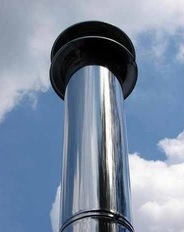Over the time, most chimney chase covers rust out and need replacing. The chase cover is the piece of metal that covers the entire top surface of your chimney housing and extends over the exterior edges of the siding. It is a cap that seals off the top of a wood-framed or brick laid chimney chase. Chimney chase covers are typically made from low-grade steel, which will rust over a short period of time. Chase covers can be made of copper or stainless steel, but more often than not galvanized steel is used to keep costs down.
 A chase cover serves a more important purpose than just keeping the top of the chimney pretty. It also protects the inside of the flue and chimney by sealing in some heat and sealing out the weather, preventing pests and rain from entering down your flue but letting air and the smoke out when necessary.
A chase cover serves a more important purpose than just keeping the top of the chimney pretty. It also protects the inside of the flue and chimney by sealing in some heat and sealing out the weather, preventing pests and rain from entering down your flue but letting air and the smoke out when necessary.
The smallest gap or hole on the chase cover can lead to expensive water damage. If you’re noticing a leak or rust stains down the side of your chimney, it is time to replace the rusted cover with a stainless steel cover. Luckily, stainless steel covers will never rust, so this will be a one-time fix. When the chase cover starts to rust, it might start dripping rust stained water onto the exterior chimney siding, creating an unpleasant dripping eyesore for the neighborhood to stare at.
Chase covers are standard on pre-fabricated/manufactured fireplaces. Most are installed with galvanized metal that rusts after this coating wears off. A battered and rusted chase cover can lead to moisture problems and mold growth in the framed chase that supports and hides your fireplace and chimney system. As with other fireplace and chimney problems, catching it early will cost less and help prevent avoidable safety issues and costly interior repairs. Herewith step to install the chimney chase cover.
- Getting started. The tools that are needed to successfully replace your chimney chase cover are the following: hammer, flat or Phillips head screwdriver, drill, steel cutting drill bit, razor knife, caulk gun, and 1 tube of weather proof silicone.
- Removing the rain cap. Start by using the flat or phillips head screwdriver and remove the rain cap from the vent pipe. There are generally 3 screws located on the side of the rain cap. Make sure save the screws so it can reuse them to put the rain cap back on.
- Remove the storm collar. Use the razor knife and cut the silicone away from the collar and the vent pipe. If the storm collar shows no sign of rust, hold on to it and reuse it.
- Remove the rusted chase cover. Using the hammer, remove the nails from the sides of the chase cover. Sometimes you will find nails on the top of the cover. Once you remove the nails, take the rusted cover off of the chimney.
- New chimney chase cover. Slide the vent pipe through the collar of the chase cover and place the new chimney chase cover on the chimney.
- Drill pilot holes. On the sides of the chase cover, also known as the skirt, drill a pilot hole on each corner. For a larger cover, you will want to have a few more for added stability. For best results, put your drill on a low speed when trying to drill through stainless steel. Once the pilot hole is tapped, use stainless steel screws to screw the chimney chase cover to the chase.
- Replace the storm collar. Place the storm collar around the vent pipe resting it on the top of the chimney cover. Use the caulk gun and tube of silicone to seal around where the storm collar meets the vent pipe. This will keep any rain from getting down the side of the vent pipe inside the chimney.
- Reconnect the rain cap. Place the rain cap back on the vent pipe. Use the screws that you saved to attach the rain cap. If the rain cap is showing signs of rust, it may be time to replace it.
- Finished! The project of replacing the rusted chimney chase cover is in the final stage, a new stainless steel chimney chase cover is on place. Repaint the chimney chase for a wonderful finished look. This will be a time fix because the stainless steel will not rust.
